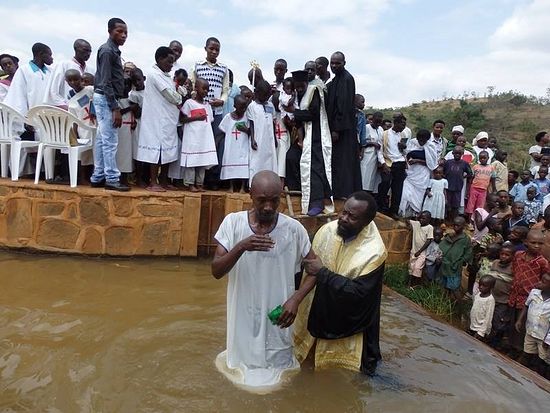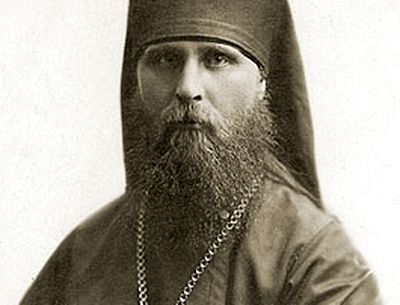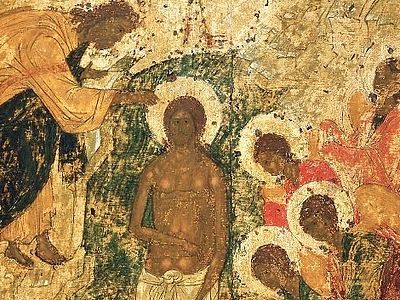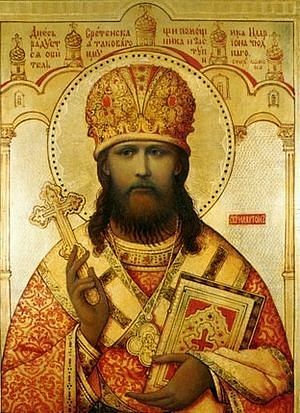 St. Hilarion Troitsky
St. Hilarion Troitsky
The ecumenical movement, often blurring the lines between the Orthodox Church and those bodies outside of it, continues to this day. In the spirit of St. Hilarion and taking inspiration from him, Fr. Peter Alban Heers, an American priest serving in the village of Petrokerasa outside of Thessaloniki, who received his D.Th. from the School of Theology, Aristotle Univeristy of Thessaloniki for his dissertation concerning the ecclesiology of the Roman Catholic church's Vatican II Council, delivered an address to the academic conference Ecumenism: Origins, Expectations, and Disenchantment held at the University of Thessaloniki between September 21 and 24, 2004.[1] This address, upholding the Church's traditional understanding of her own unity and the unity of her baptism, we offer below:
* * *
“The Church can be experienced and ‘tasted’ only from the inside and not externally: without the right faith (orthodoxy) and outside of living a life according to this faith, the Church does not exist.”—Metropolitan Amphilohije of Montenegro, The Church as the Pillar and Stronghold of the Truth: The Question of Autocephaly and the Church
Your Eminences, Reverend Fathers, Beloved Brethren in Christ, Ladies and Gentlemen,
The Orthodox Church’s understanding of heterodox baptism flows from and is determined by its self-understanding of being the “one, holy, catholic, and apostolic Church,” which alone performs the one baptism into the death and resurrection of Christ. This is so, for the Church is known in her mysteries.[2] In and through the mysteries the Church exists and is continually formed, her borders are set, her members identified. “Those who live their lives outside the mysterial (sacramental) life are outside the body of Christ.”[3]
The “One Baptism” and the Baptism of Heretics
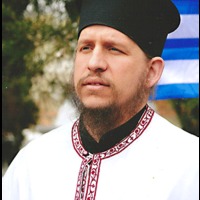 Fr. Peter Alban Heers, D.Th.
Fr. Peter Alban Heers, D.Th.
Ecclesiastical Economy
And, yet, as the Church is “in a full sense the steward and sovereign administrator of the sacraments . . . it falls within the scope of her stewardship and economy to make valid—if she so thinks fit—sacraments administered by non-Orthodox, although such sacraments are no sacraments if considered in themselves and apart from the Orthodox Church.”[10] Hence, the holy canons and Holy Tradition also provide for the application of “ecclesiastical economy.” This therapy of anti-canonicity applies to those ailing in faith and ecclesiastical communion (i.e. heretics and schismatics), who nevertheless, “preserve faith in the Trinitarian nature of God and fundamentally retain the canonical baptismal type,”[11] that is, “administering baptism with triune immersion and emersion according to its Apostolic and patristic form.”[12]
The Place and Limits of Economy
The application of economy, however, in no way implies “recognition of the validity of non-Orthodox sacraments per se, it is something that concerns only the sacraments of those entering the Orthodox Church.”[13] This is so because heresy and schism incur disconnection from the one Church and consequently loss of apostolic succession and canonical priesthood.[14] The Church, then, always guided by pastoral concerns, exercises economy on particular occasions only “when this aids the reconciliation of the heterodox without obscuring the truths of the Orthodox faith.”[15] Economy always moves within the spirit and will of the rule of faith and aims at the same goal, having exactitude as its measure and the principles laid down in the Gospel as its guide. “If ‘economy’ transcends the canon, it cannot, however in any case militate against it . . . [I]t can be transcendent, never, however, subversive.”[16]
Whether the Church, then employs the «κατ’ ακρίβειαν» therapy of baptism or the «κατ’ οικονομίαν» therapy of chrismation or confession of faith, it signals “no change in Orthodox ecclesiology or sacramental theology, but simply a change in disciplinary practice.”[17]
An Ecclesiological Framework for the Recognition of Heretical Baptism per se
In stark contradiction to this understanding stands a string of baptism-related documents signed and statements made by Orthodox ecumenists in Australia, America, the Vatican, Lebanon, and elsewhere. Indeed, these statements are essentially compatible with Roman Catholic ecclesiology, and appear to derive from it. This ecclesiology contains a teaching on heretical baptism that has its roots exclusively in the Latin theological world, received its clearest conciliar adoption at the Council of Trent, and was given an innovative expression at the Second Vatican Council.
A Distorted Ecclesiology
Medieval Papalism “presupposes a peculiar additional mystery about itself as a worldwide organization whose jurisdiction extends beyond the continuously visible and concrete assembly of the body of Christ.”[18] Having lost diachronic unity with the Tradition and the Fathers, and having come to understand “catholicity as mere ecumenicity or global universality,”[19] with Rome as the center, Roman Catholicism “set aside the Church’s charismatic dimension and eschatological perspective,”[20] thereby realizing “the secularization or ‘religionization’ of Christianity.”[21]
Rome Condemns St. Augustine’s Teaching
 St. Augustine
St. Augustine
Pope St. Stephan and the Defense of Heretical Baptism
Modern Roman apologists declare that they follow neither St. Cyprian nor ST. Augustine in their “rigorism,” but are children of Pope St. Stephan “who would not allow heretical baptism to be impugned.”[25] This rejection of the African Fathers’ positions is not new, but dates back at least to the thirteenth century. From as early as the Lateran Council[26] in 1215, baptism performed by any layman, including a heretic, one unbaptized, or even an unbeliever, is accepted if it preserves the right external form and he who baptizes has the intention to perform that which the Church performs.[27] This position was repeated at the Council of Florence (1438-1445), while the Council of Trent (1545-1563) goes so far as to anathematize “anyone who says that baptism performed by heretics is not valid.”[28] The Roman Catholic Codes of Canon Law from 1917 and 1983 likewise confirm this position.[29]
The Theological Schism of Vatican II
This brings us to contemporary Roman Catholicism and the decisions of the Second Vatican Council.[30] In his analysis of the decisions of Vatican II, Fr. John Meyendorf calls to our attention two aspects of Rome’s new decrees—decrees which combine to create a fundamental theological discord. On the one hand, as is specified in the Decree on the Church (III, 22), those bishops which do not have communion with the throne of Rome have no dogmatic authority whatsoever. On the other hand, there exist “valid” mysteries performed outside the Church, such that it is possible to accept the idea of partial communion[31] and a limited practice of sacramental communion with separated Christians. Combining these two ideas there appears “a legalistic notion of the Church, which sees it as a worldwide institution of control and dogmatic security, separating the Christ of the mysteries from dogmatic Truth.” Hence, there is created “a theological schism between the sacramental presence of Christ and His revelation as unique Truth,” with “the authority of expressing dogmatic teaching [being] separated from the reality of the mysteries.”[32]
The Recognition of Heretical Baptism per se by Orthodox Ecumenists
Having, thus, touched upon ecclesiological point of interest in Latin sacramental theology, we can better understand recent agreements and statements by Orthodox ecumenists. Although there were some scattered Orthodox who even before Vatican II upheld the legitimacy of heterodox baptism per se,[33] under the apparent influence of the council and its “opening up” of new possibilities, the number has risen dramatically.
As early as 1975 Archbishop Athenagoras Kokkinakis of Thyateira and Great Britain (of the Ecumenical Patriarchate) in his synodically-blessed and authorized “Thyateira Confession” declared that “all Christians believe in the same Baptism by which all have become members of His Body the Church.”[34] Ten years later, the then lay theologian John Zizoulis (present day Metropolitan of Pergamon), proposed speaking “of the limits of the Church on the basis of . . . baptismal unity.”[35] He declared that it is baptism which delineates the boundaries of the Church, and that all Christians are baptized. Thus, it follows that “[w]ithin baptism, even if there is a break, a division, a schism, you can still speak of the Church.”[36]
Six years later, in Balamand, Lebanon, the now famous “Balamand Agreement” was formulated. Among its declarations, the claim of a “common baptism” stood out, and under the shadow of the importance of Vatican II:
13) . . . since the Pan-Orthodox Conferences and the Second Vatican Council, the rediscovery and the giving again of proper value to the Church as communion, both on the part of Orthodox and of Catholics, has radically altered perspectives and thus attitudes. On each side it is recognized that what Christ has entrusted to His Church—profession of apostolic faith, participation in the same sacraments, above all the one priesthood celebrating the one sacrifice of Christ, the apostolic succession of bishops—cannot be considered the exclusive property of one of our Churches. In this context it is clear that rebaptism must be avoided (emphasis mine).
On the heels of the Balamand Agreement, the Primate of the Church of Constantinople likewise contributed a declaration of “baptismal unity.” In the Joint Declaration “Call to Unity” of Pope John Paul II and Patriarch Bartholomew on June 29, 1995, the following declaration was made: “A common sacramental conception of the church has emerged, sustained and passed on in time by the apostolic succession . . . we urge our faithful, Catholics and Orthodox, to reinforce the spirit of brotherhood which stems from the one baptism and from participation in the sacramental life.”
Metropolitan Maximos of Aenos (Ecumenical Patriarchate), a fervent supporter of the Balamand Agreement, also believes that the Orthodox teaching recognizes heterodox baptism per se. He declared the following in his diocesan journal: “When we profess faith in one Christian baptism for the forgiveness of sins, we do not mean by that Orthodox baptism, but any Christian baptism.” “Orthodoxy and Roman Catholicism, the two ‘sister churches’ of old continue to recognize one another’s baptism, as well as the other sacraments celebrated in these churches.” “The rebaptism by Orthodox of baptized heterodox Christians is inspired by ‘narrow-mindedness, fanaticism and bigotry.’” “[It] is an injustice committed against Christian baptism, and eventually a blasphemy against God’s Holy Spirit Who is at work at any Christian baptism.”[37]
Metropolitan Maximos, Bishop Demetrios of Xanthou, Fr. Alexander Golitzin [now Bishop (OCA)—ed.], Fr. Alkiviadis Calivas, Professor John Erickson and others were among the Orthodox representatives who signed the Agreed Statement of the North American Orthodox-Catholic Theological Consultation on “Baptism and Sacramental Economy.” Issued in 1999, it was an attempt to answer critics of the Balamand Agreement as well as to issue a critique of sacramental economy. Besides labeling St. Nikodemos the Athonite an “innovator” for his contribution to the Church’s tradition regarding economy, the Consultation stated the following:
The Orthodox and Catholic members of our Consultation acknowledge, in both of our traditions, a common teaching and a common faith in one baptism, despite some variations in practice which, we believe, do not affect the substance of the mystery. We are therefore moved to declare that we also recognize each other's baptism as one and the same. This recognition has obvious ecclesiological consequences. The Church is itself both the milieu and the effect of baptism, and is not of our making. This recognition requires each side of our dialogue to acknowledge an ecclesial reality in the other . . . In our common reality of baptism, we discover the foundation of our dialogue, as well as the force and urgency of the Lord Jesus' prayer that all may be one. Here, finally, is the certain basis for the modern use of the phrase, "sister churches."[38]
For our purposes here, what should be clear is the important role the Roman Catholic theory of “baptismal unity” played in this agreement. In this brief analysis of the document, Metropolitan Hierotheos (Vlachos) of Nafpaktos declares the falsity of “baptismal unity” and rightly identifies it as simply another version of the much-condemned “branch theory.” He wrote that it is “obvious that [Orthodox] ecumenists understand the acceptance of the baptism of heretics (Catholics and Protestants, who have altered the dogma of the Holy Trinity and other dogmas) to mean accepting the ecclesial status of heretical bodies and, worse still, that the two “Churches,” Latin and Orthodox, are united in spite of “small” differences, or that we derive from the same Church and should seek to return to it, thereby forming the one and only Church. This is a blatant expression of the branch theory.”[39]
An expression of the branch theory on the basis of a “common baptism” is also clearly found in a text adopted and signed by Orthodox ecumenists at the Second European Ecumenical Assembly of the Council of European Churches in June of 1997. There we read: “In the baptismal water we recognise the presence of the Spirit, who is the source of all life and makes us part of the body of Christ.”[40] “We recommend that the churches . . . seek to achieve mutual recognition of baptism among all Christian churches.”[41]
Finally, in July of this year (2004), the Australian dioceses of the Patriarchates of Constantinople, Antioch, and Romania signed the so-called “Covenanting Document” of the National Council of Churches of Australia, whereby they recognize the sacrament of baptism administered in the heterodox communities (Roman Catholic, Non-Chalcedonian, Anglican, Lutheran, Congregationalist, and Uniting) and promote the use of a common “Certificate of Baptism.”[42] That is to say, Orthodox hierarchs in Australia, and by implication in Constantinople, Damascus and Bucharest, have recognized baptism as existing per se in the heterodox confessions. Although unprecedented for the Orthodox, this agreement is consistent with the Second Vatican Council declaration, namely, that “men who believe in Christ and have been properly baptized are brought into a certain, though imperfect, communion with the Catholic Church . . . all who have been justified by faith in baptism are incorporated into Christ; they therefore with good reason are accepted as brothers by the children of the Catholic Church.[43] . . . Baptism is, then, the sacramental bond of unity, indeed the foundation of communion among all Christians.”[44] (Emphasis mine)
Conclusion: Call for a Return to Strictness
The views presented by these Orthodox theologians and hierarchs are clearly resonant with those held by Roman Catholic theologians, views especially pronounced and developed since the Second Vatican Council. They are views which are set against the Patristic consensus and the canons of the Church; views which compromise the integrity of the Church and hinder her mission. Above all they are views which disregard the preeminence of faith with regard to unity—every kind of unity, whether so-called “partial” or “full.” As St. John Chrysostom has stated, “When all believe alike, then unity exists.”[45]
The Patristic witness on the question of heretical baptism has never been in question, despite recent claims to the contrary. St. Athanasius the Great, for example, clearly regarded right Faith as essential for the accomplishment of a genuine and grace-giving baptism. His words succinctly express the Patristic consensus:
On this account, therefore, the Saviour also did not simply command to Baptize, but first says, Teach; then thus: Baptize in the Name of the Father, and Son, and Holy Spirit; that the right faith might follow upon learning, and together with faith might come the consecration of Baptism. There are many other heresies, too, which use the names only, but not in a right sense, as I have said, nor with sound faith, and in consequence the water which they administer is unprofitable, as deficient in piety, so that he who is sprinkled by them is rather polluted by irreligion than redeemed[46] (emphasis mine).
Alas, greatly lacking is the kind of clarity and directness with which St. Athanasius speaks. This is because in the papist-ecumenist vision of baptism and the Church there is incredible inner confusion and contradiction, which we are encouraged to believe is really paradox or antinomy.[47] It is not. It is just plain over-logicalness twisting reality in order to conform to the dysfunctional forms of Western Christian life.[48] And, yet, “baptismal unity” represents the dominant thought in ecumenical circles—including among Orthodox ecumenists. Herein lies the great tragedy and travesty of Orthodox “witness” in the ecumenical movement. By embracing the so-called theory of “primordial unity” in the “one, common baptism” Orthodox ecumenists have pitted charity against truth and further obscured the existing “dis-union.”[49]
What, then, is called for now, in the face of this infidelity? As in times past, when “leniency seemed to endanger the well-being of the Orthodox flock, exposing them to infiltration and encouraging them to indifferentism and apostasy,”[50] the Church must “resort to strictness”[51] in the reception of heterodox. As a contemporary hierarch has written—and with this I conclude my remarks: “When there is such confusion, it is necessary to adopt an attitude of strictness, which preserves the truth: that all who fall into heresy are outside the Church and that the Holy Spirit does not work to bring about their deification.”[52]
Epilogue: A Matter of Faith
Not many days after this paper was presented, another ecumenistic agreement was announced. The Evangelical Church in Germany (EKD)—the country's main Protestant denomination—and the Ecumenical Patriarchate of Constantinople signed an agreement to recognise one another’s baptisms. The agreement was summarized as follows in an article which appeared on October 6th from Ecumenical News International:
Under the agreement announced after a September meeting in Istanbul, Christians who convert from one denomination to another will not be baptized again. The joint statement which was signed declared that “although church fellowship does not yet exist between our churches, we each regard the other's members as being baptized and in the case of a change of confession we reject undertaking a new baptism.” The statement was signed by Metropolitan Augoustinos of Germany of the Ecumenical Patriarchate, and Bishop Rolf Koppe, head of foreign relations for the EKD. Dr. Dagmar Heller, the EKD officer responsible for ecumenism and Orthodoxy stated that "During our negotiations Metropolitan Augoustinos pointed out that the Ecumenical Patriarchate in Germany has not baptized converts for many years. But signing this paper helps to combat misunderstanding and prejudices." A major World Council of Churches-sponsored conference earlier this year highlighted the importance of the mutual recognition of baptism, considered by some to offer currently the most promising way to promote church unity. In 2003, the then WCC general secretary, Konrad Raiser, said there would be "a 'Copernican Revolution' in ecumenical dialogue if churches were genuinely to recognise each other's baptism.”
There are several important matters to note and analyze here. First of all, this agreement clearly continues the path previously mentioned, namely, the recognition of heterodox baptism per se (in and of itself, apart from conversion to Orthodoxy) and does away with even the possibility of economy, since here economy has become the rule. For what is there to “economize” and complete if the fullness of baptismal grace already exists among the heterodox?
Secondly, unlike those agreements reached in Balamand and in the U.S.A., this agreement was reached in Constantinople, at the Phanar, and signed by the Bishop of a local Church. In the past, as a way of mollifying criticism, it has been claimed that these ecumenist decisions were only suggestions by theologians in dialogue and not decisions of local Bishops. With the pacts signed in Germany and Australia we are dealing not with commissions of theologians or theological accords which are not yet enforced, but local dioceses (Churches) under Bishops who are signing confessions of faith. They believe—and confess—that there is no difference between Orthodox and heretical baptism, that they are one and the same—the “one baptism” of the Symbol of Faith (Nicene Creed). This is a direct challenge to every Orthodox Christian’s faith in the “one baptism for the remission of sins” and the belief that the “one church” of the Creed is the Orthodox Church.
Every Orthodox Christian is in essence being asked: Do you believe and confess that Orthodox and heterodox baptism are one and the same—are both the “one baptism for the remission of sins”? If, however, you accept that the “one baptism” we confess in the Symbol of Faith is the same as that “baptism” performed by the heterodox, it follows that the “one Church” is identified with a “church” to which the heterodox also belong.
Moreover, if the heterodox are baptized into Christ and into the life of Christ, have “put on Christ” in baptism, then they lack nothing of the Grace of God and surely the only thing which prevents them from sharing in Holy Communion with the Orthodox is prejudice and misunderstanding. For, if dogmatic truth is no longer a necessary criterion for membership in the Church, we will find no reasons other than prejudice and misunderstandings to refrain from union.
One can expect claims that nothing has changed, that the practice of receiving the heterodox «κατ’ οικονομίαν» by chrismation was the norm for decades and it will continue to be. If the practice has not changed—a practice, which St. Nikodemos the Athonite’s interpretation calls into question—how it is understood definitely has changed. Although nowhere in the agreement is it stated that the heterodox baptism is considered by the Orthodox as inactive or lacking, some are now justifying the decision on the grounds that the Orthodox consider heterodox baptism to be a baptism «ἑν δυνάμει» (potential), and not «ἑν ἐνεργεία» (active). Besides the fact that this is stated nowhere in the agreement—and thus the Orthodox appear like Jesuits (saying one thing and thinking another)—“baptism ‘ἑν δυνάμη’” is unknown among the Fathers. What Father ever spoke of mysteries existing «ἑν δυνάμη» among the heterodox?
Dear Orthodox Christians, the canonical and patristic witness is clear. The 46th and 47th Apostolic Canons declare, respectively: “We order that a bishop or presbyter that recognized the baptism or sacrifice of heretics be defrocked. For what accord has Christ with Belial? Or what has a believer in common with an unbeliever? (c.f. 2 Cor. 6:15) and “If a bishop or presbyter baptize anew anyone that has had a true baptism, or fail to baptize someone that had been polluted by the impious, let him be defrocked, on the grounds that he is mocking the cross and death of the Lord, and fails to distinguish priests from false priests.”
More important, however, than even the anti-canonical nature of these agreements, if it be possible, is the implication that fundamental differences in faith no longer prevent us from effecting union with the heterodox. What we have here, is no less than a "false union," plain and simple—union of the churches in the “one baptism” of the Church. A confession of faith has been posited, one which says that the “one baptism” is every baptism, whether it be performed within or outside of the Church, by an Orthodox Christian or a heterodox, according to apostolic form or not. Furthermore, by implication, this new confession of faith also holds that, since we share the “one baptism” with the heterodox, and enjoy so-called partial union with them, they too are members of the Church—even if, perhaps “ecclesiastically lacking” in some way.
Every Orthodox Christian—especially every Orthodox shepherd—is called upon to resist this new “confession of faith” in word and deed and be ready always to give an answer to every man that asketh a reason of the hope that is in them (1 Pet. 3:15).
